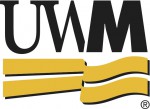UWM physicists play key roles in first-ever observations of explosive neutron star collision
UW-Milwaukee members of the LIGO/Virgo Collaboration were instrumental in detecting the signal .
MILWAUKEE _ Scientists at LIGO, Virgo and astronomical observatories around the world announced today the discovery and observations of the collision of two neutron stars.
These are the first observations of a cosmic event in both gravitational waves and the more familiar electromagnetic wavelengths (visible, infrared and ultraviolet light, radio waves, gamma rays, etc.).
UW-Milwaukee members of the LIGO/Virgo Collaboration were instrumental in detecting the signal from the LIGO detectors and analyzing the gravitational waves from the collision. In addition, UW-Milwaukee astronomers who are not members of the LIGO team played a major role in the discovery and making observations in the electromagnetic radiation.
On Aug. 17, a LIGO scientist noticed that the computer had flagged an interesting signal that had the character of a collision between orbiting neutron stars, but it came from only one of the two LIGO detectors. Normally such a detection requires both detectors, but the scientist noticed that NASA’s Fermi Gamma-ray Space Telescope also detected a burst of gamma rays at the same time. These signals were unlikely to be coincidences, and LIGO soon found the signal in the second LIGO detector. Having the Virgo detector in Italy made it possible to determine the location of the event with relatively high precision.
The gravitational scientists notified their astronomical colleagues who, using a new catalogue of relatively nearby galaxies, found the explosion only 10 hours after it happened in NGC 4993, a galaxy about 130 million light-years away in the constellation Hydra. The identification allowed observations of the event in a wide array of wavelengths, employing traditional optical observatories, radio telescopes and satellites. All told, hundreds of astronomers around the world, using telescopes on all seven continents and in space, followed this event frantically as the source disappeared into twilight. And UWM was right there in the middle of it.
Scientifically, the observations promise to:
- Explain the existence in the universe of elements heavier than iron
- Explain the origin of short “gamma-ray bursts”
- Give us new insight into the nature of matter
The combined observations promise to dramatically enhance our understanding of ways the primordial elements – hydrogen and helium – are transformed into the stuff from which planets – and we – are made. In particular, it illuminates processes that create elements heavier than iron – including precious metals like gold, platinum and so-called rare-earth elements – whose origin has been something of a mystery.
David Kaplan, associate professor of physics at UWM and a radio astronomer who co-authored a paper on the findings of various electromagnetic observations, said the event offered an unprecedented opportunity to observe the conditions under which heavy elements can be synthesized.
“We’ve never witnessed a collision between binary neutron stars,” he said. “We believe we’re seeing the creation of elements whose origin has been a mystery up until now.
“We’re seeing these elements being created, and we’re also starting to get a better handle on how they are being made.”
“This event could create a mass of gold equal to the mass of Saturn,” Kaplan added. “Imagine a sphere three times the size of Earth, but 100 times more massive – that’s the amount of gold we’re talking about.”
Jolien Creighton, who leads the LIGO effort to detect and measure massive binary collisions, said the observation of the collision of neutron stars offers a window into some of the most exotic matter the universe has to offer.
“We’re talking essentially about giant atomic nuclei,” Creighton said. “We know they exist, but the physical laws that govern them have been difficult to pin down.
“This sort of observation is going to help us understand these objects and the fundamental nature of dense matter.”
Brady highlighted other notable implications of the discovery.
“There are phenomena, known as short gamma-ray bursts, whose origin was unknown,” Brady said. “Based on what we saw in August, it’s pretty clear that they are in fact colliding neutron stars.”
But colliding neutron stars offer even more science.
“We get to test if gravity travels at the same speed as light,” he said. “And we have a chance to get a better handle on the rate at which the universe is expanding, which in turn will help make better measurements of distances in the universe.
“And we’re just getting started,” Brady added. “We expect to learn more as our analysis goes on — and there’s always the potential for the unexpected.”
About UWM
Recognized as one of the nation’s 115 top research universities, UW-Milwaukee provides a world-class education to 26,000 students from 89 countries on a budget of $667 million. Its 14 schools and colleges include Wisconsin’s only schools of architecture, freshwater sciences and public health, and it is a leading educator of nurses and teachers. UW-Milwaukee partners with leading companies to conduct joint research, offer student internships and serve as an economic engine for southeastern Wisconsin. The Princeton Review named UW-Milwaukee a 2018 “Best Midwestern” university based on overall academic excellence and student reviews, and the Sierra Club has recognized it as Wisconsin’s leading sustainable university.
About GROWTH
GROWTH (Global Relay of Observatories Watching Transients Happen) is an international collaborative project in astronomy, funded by the National Science Foundation under PIRE Grant No 1545949, with additional support from Japan Society for the Promotion of Science, the Ministry of Science & Technology in Taiwan, and the Science and Engineering Research Board, Department of Science and Technology in India. Led by the California Institute of Technology, GROWTH is a partnership among 14 institutions in the USA, Japan, Taiwan, India, Israel, Sweden,Germany and the UK.
NOTE: This press release was submitted to Urban Milwaukee and was not written by an Urban Milwaukee writer. While it is believed to be reliable, Urban Milwaukee does not guarantee its accuracy or completeness.
























